Marlene Pardo Pellicer's Blog
December 26, 2022
Old Time Superstitions
 by M.P. Pellicer | Stranger Than Fiction Stories
by M.P. Pellicer | Stranger Than Fiction StoriesSuperstitions come in many forms for different people, but some take it more seriously than others.
 Some believe in superstitions, just in case At the turn of the century progress was in the air, but those customs that could bring you good fortune and ill as well could not be forgotten.
Some believe in superstitions, just in case At the turn of the century progress was in the air, but those customs that could bring you good fortune and ill as well could not be forgotten.Actors were known to be the most cautious. They wouldn't whistle or kill a spider in the dressing room. Directors wouldn't start a movie or a journey on Friday the 13th.
Those in the Low Country believed that if someone puts the shape of a coffin made of string in front of the door, someone in the house would die. A dog howling underneath a window at night forewarned of the same event.
If you were going to brag then knock on wood or underneath a table if it's made of that material.
If you had hairy arms you would be rich. Hairs on the legs meant that you would be raising pigs. Tea leaves in a cup of tea meant visitors would soon arrive.
A verse about sneezing:
Sneeze on Monday, sneeze for danger
Sneeze on Tuesday, kiss a stranger
Sneeze on Wednesday, sneeze for a letter
Sneeze on Thursday, something better
Sneeze on Friday, sneeze for sorrow
Sneeze on Saturday, joy tomorrow.
 Two movies were made in 1982 and 2001 with the title of Superstition Other superstitions were:Never to return borrowed salt;Never turn back when once started on a journey;A spell of laughing is a sign that you will surely be crying before bedtime;Thirteen is also an unlucky number;If your ears burn someone is talking about you;If your nose itches on the left side a gentleman is coming, if it itches on the right side, a lady is coming;If when your finger is itching you scratch it on wood and make a wish, then the wish will come true;Turn your money over before you speak when you see a new moon and it will increase;Wishing on the first star out and on eyelashes is frequently doneAlso when two people say the same word together if the finger is bitten, and linked into the other person and both make a wish the first one that speaks loses the wish. However if you think that the belief in superstition is a thing of the past even now, movies are made about the subject.
Two movies were made in 1982 and 2001 with the title of Superstition Other superstitions were:Never to return borrowed salt;Never turn back when once started on a journey;A spell of laughing is a sign that you will surely be crying before bedtime;Thirteen is also an unlucky number;If your ears burn someone is talking about you;If your nose itches on the left side a gentleman is coming, if it itches on the right side, a lady is coming;If when your finger is itching you scratch it on wood and make a wish, then the wish will come true;Turn your money over before you speak when you see a new moon and it will increase;Wishing on the first star out and on eyelashes is frequently doneAlso when two people say the same word together if the finger is bitten, and linked into the other person and both make a wish the first one that speaks loses the wish. However if you think that the belief in superstition is a thing of the past even now, movies are made about the subject.
Published on December 26, 2022 08:00
December 24, 2022
Till Death Do Us Part
 By M. P. Pellicer | Stranger Than Fiction Stories
By M. P. Pellicer | Stranger Than Fiction StoriesBert was a busy boy, even as far back as 1895 when he was part of Ohio's Willshire Wheat thieves and was sentenced to 4 years. Unfortunately he would become known to authorities for far grimmer reasons.
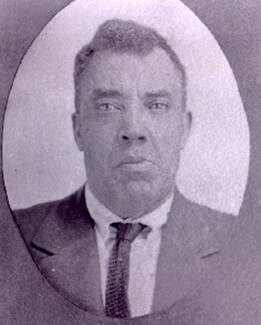 Bert Highwarden (1875-1924) Sixteen years later Wilson Bertrim "Bert" Highwarden was facing a grand jury for killing his ex-wife.
Bert Highwarden (1875-1924) Sixteen years later Wilson Bertrim "Bert" Highwarden was facing a grand jury for killing his ex-wife.They were married in 1895, and she'd born him 7 children, 5 which were alive when he shot her dead. Mabel Ada was only 31 years old.
It seemed the populace of Springfield, Ohio felt harshly against Bert, so much so, that it was decided to arraign him at night and take him to the county jail which was deemed more secure.
The couple had a stormy married life for several years and had separated in the springtime. The police had been called several times to their home. Ada as she was known, applied for a divorce and it was granted two months before her death.
She worked in Troy as a domestic, and left her children with relatives in Springfield. She had returned the day before to Urbana to finalize monetary support for their children, and the couple had spent part of the afternoon in the office of Mrs. Highwarden's attorney. They did have a disagreement besides her refusal to reconcile with him, in which she wanted to send their 5 children to the Children's Home and he opposed the plan.
He killed her half an hour later, as she was preparing to leave back to Springfield. She even had her hat in her hand.
The only witness to the crime was Bert Highwarden, who had come to Ada's mother's house on South Kenton Street at around 4 p.m. Shots rang out, and Ada's mother, Sarah Roberts, rushed to the front room and found her daughter lying on the floor with blood gushing from her wounds.
Constable Dave Brown who lived a block away ran to the scene. When Dr. Houser arrived she was already dead.
Highwarden turned himself into the sheriff along with the .45 caliber revolver he used. It was believed that her refusal to reconcile with him caused the tragedy. He said to the chief of police, "She got what was coming to her." He added that his, "wife had caused his arrest and sold his furniture and gone to live with a neighbor where she would be near another man, and that he had said he would kill her if she didn't cut it out and that he had kept his word."
 Bert Highwarden killed his 2nd wife after having been pardoned for the murder of his 1st wife Bert Highwarden in the past was known to be addicted to alcohol, but had not been drinking when he killed Ada. During the divorce Highwarden had never claimed his wife had been unfaithful to him.
Bert Highwarden killed his 2nd wife after having been pardoned for the murder of his 1st wife Bert Highwarden in the past was known to be addicted to alcohol, but had not been drinking when he killed Ada. During the divorce Highwarden had never claimed his wife had been unfaithful to him.He once worked as a driver for a company called Mammoth, and he was currently employed as a hostler and would make the circuit of the county fairs in Ohio.
The autopsy found that only one bullet had caused Ada's death. It entered about an inch above the bridge of the nose and came out at the left temple, making a wound about 3 inches long and it penetrated the front lobe of the brain. The wound had powder burns which indicated the the weapon was held close to her head. It was thought that Highwarden held his wife with one arm, and operated the pistol with the other hand.
In October, 1911, Bert Highwarden which had been indicted for first degree murder entered a plea of not guilty. He went to trial at the end of the December and on January 4, 1912, he was found guilty of murder in the second degree and sentenced to life imprisonment.
In 1917, Bert Highwarden was granted clemency by Governor Grants. Within a few years, he made the governor sorry he had pardoned him because on August 1924, he killed his second wife Rovilla. She was 35 years old, and had petitioned the court for a divorce. Like the first murder, he walked to the police station and gave himself up afterward.
Rovilla was buried on August 20, at Oak Dale Cemetery.
On that same day witnesses were brought before the coroner's inquest since the crime occurred on the street.
One of them was Caroline Moss, sister-in-law of the victim.
They testified that Rovilla Highwarden fell from the first shot, and Bert Highwarden leaned over, took deliberate aim and fired a second shot.
The coroner confirmed that she had died from a facial gunshot wound from a .32 caliber revolver.
In September, 1924, Bert Highwarden pled not guilty at this arraignment to the charge of first degree murder.
On October 23, he was convicted of first degree murder without mercy, and sentenced to die in the electric chair on February 9, 1925. He was executed on that date. He was 50 years old.
Strangely enough, August seemed to be a significant month for him. He killed his first wife Mabel on August 1, 1911, and his second wife Rovilla on August 18, 1924.
Source - Lancaster Eagle Gazette
Published on December 24, 2022 08:00
December 12, 2022
Strange Discoveries in Minnesota
 By M.P. Pellicer | Stranger Than Fiction Stories
By M.P. Pellicer | Stranger Than Fiction StoriesIn March, 1921, George Bacon claimed that more than 30 years before he had made a startling discovery deep in a Minnesota cave.
 George Bacon's discovery was retold 30 years later Bacon was a farmer in Fountain, Minnesota, but his discovery took place when he was 11 years old and running in the woods near Preston.
George Bacon's discovery was retold 30 years later Bacon was a farmer in Fountain, Minnesota, but his discovery took place when he was 11 years old and running in the woods near Preston.He'd gone hunting for a wildcat which he though was raiding his farm. The day after he set the trap, he found a trail of blood and fur leading away from the grove near his home.
The family offered a cash reward, and a neighbor boy said he knew where the animal was hiding.
A party of boys and men decided to follow the hunt.
They trekked through 12 miles, and some of the boys who had gone ahead came to the entrance of a great stone archway. It was partially hidden by a tangle of vines.
The entrance was narrow, and they collected $3 from among those who were there, to be given to one boy who could wiggle inside. That boy was George Bacon. After two other boys lost their nerve about entering, he took a lantern with him and cautiously made his way inside. Under a projecting rock there was drop off of about four feet. There he found the dead wildcat.
The boy crawled on for 12 rods and then received a shock which caused him to forget all about the object of his adventure. Against the cave wall lay the body of an elderly woman, enveloped by a long shawl. Her arms were crossed on her bosom. The features were coarse, but quite unlike those of any Indian he had seen.
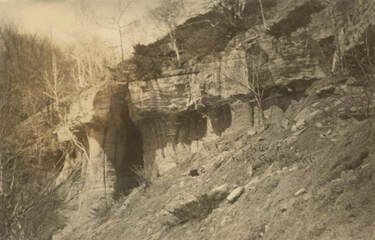 Indian cave in Rushford, Minnesota c.1909 She had dark hair, and the feet only had on leather sandals.
Indian cave in Rushford, Minnesota c.1909 She had dark hair, and the feet only had on leather sandals.He crawled back out and told the men gathered what he found. They tried to squeeze in, but the entrance was too narrow. They gave up and returned home. Bacon also returned with the wildcat and the trap. He was given the reward.
Most of those in the town refused to believe George's story, and thought it was a product of a "frightened fancy". All forgot about the adventure except George and his parents. They tried to figure out a way of pulling the body out, but could not come up with a good idea.
George believed there was a fortune to be made if he could "rescue the body", however the years passed, and once he became a man he left Preston. But he never forgot about what he saw in the cave. During a trip home, and after securing legal advice from an attorney who assured him that he had the legal right to attempt recovery of the remains, he returned well equipped to the cave.
Bacon was able to crawl in, but came up against a barrier of rock that had fallen from the roof of the cave. He was afraid of shoveling against it and being buried alive.
Was it a fossil or a mummy? Experts from that time said it was neither. They said it would be impossible for a mummy to stay in an upright position, and that it could not be a petrified body unless there was excessive moisture in the cave. Which might be possible since two boys, who did crawl in as far as the rocks, said the air was very moist and the floor was damp.
Was she an Indian or Caucasian? Was she placed there once dead, or was she entombed alive, and wild beasts had dug away the stone that had been placed to seal her in?
The story revived myths of a civilization preceding the Indians.
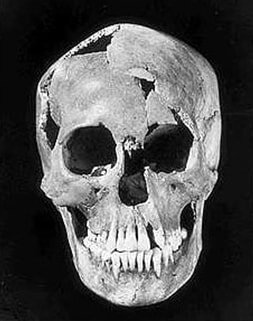 Skull of Minnesota Woman discovered near Pelican Rapids, Minnesota in 1931 In June, 1931, the skeletal remains of a woman were discovered near Pelican Rapids, Minnesota. There was construction being done on U.S. Route 59, and the bones were taken to the University of Minnesota, where Albert Jenks identified it as the skeleton of a teenage woman who had never had children. With her she had a dagger made from an elk's horn and a conch shell pendant. The conch shell came from a species which had only been known to exist in Florida. It was estimated she was 8,000 years old.
Skull of Minnesota Woman discovered near Pelican Rapids, Minnesota in 1931 In June, 1931, the skeletal remains of a woman were discovered near Pelican Rapids, Minnesota. There was construction being done on U.S. Route 59, and the bones were taken to the University of Minnesota, where Albert Jenks identified it as the skeleton of a teenage woman who had never had children. With her she had a dagger made from an elk's horn and a conch shell pendant. The conch shell came from a species which had only been known to exist in Florida. It was estimated she was 8,000 years old.Due to the discovery being made by a road crew, some of the details connected to the girl's death were hard to determine. It appears she was not ritually buried and a thin layers of shells had been placed over the body. It was suspected she might have drowned after falling through ice, or from a boat, and her body covered over in the depths of a glacial lake.
 Digging at location of Minnesota Woman's discovery c.1931 Prior to 1926, the theory was that humans had come to America in the last 2,000 years. The discovery of Minnesota Woman as she was named, disproved this theory, and proved that humans were in Minnesota near the beginning of the Archaic period.
Digging at location of Minnesota Woman's discovery c.1931 Prior to 1926, the theory was that humans had come to America in the last 2,000 years. The discovery of Minnesota Woman as she was named, disproved this theory, and proved that humans were in Minnesota near the beginning of the Archaic period.The remains were reburied on October 2, 1999, by Sioux tribes in South Dakota and further study on them is not available.
Because of its location this was not the same woman that George Bacon saw around 1890, which is about 12 miles from Preston, Minnesota.
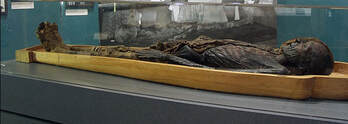 Minnesota's Egyptian mummy In 1925, a donation was made to the Science Museum of Minnesota from the private collection of Mr. and Mrs. Simon P. Crosby.
Minnesota's Egyptian mummy In 1925, a donation was made to the Science Museum of Minnesota from the private collection of Mr. and Mrs. Simon P. Crosby.This was the year it was acquired by the Science Museum lawyer and trustee Simon Crosby while on a Mediterranean trip, which stopped at Cairo. He was accompanied by his wife, daughter, and granddaughter. This was the time of the "Tutmania" craze, which accounts as to why the antiquities dealers Crosby bought it from told him it dated to the 18th dynasty.
In the 1930s, the left half of the head and torso were unwrapped.
It wasn't until the 1960s, that the first x-rays were made, and in 1983, an axial CT scan, endoscopic examination and tissue analysis were completed. It showed all internal organs except the heart had been removed, a common practice done during mummification.
The test supported the museum's theory that the remains belonged to a priest. He had a shaven head, callused feet indicative of someone who walked barefoot, and hands that did not show signs of manual labor. He had good teeth and a light curvature of the spine. He was about 30 to 35 years old
The examination indicated he lived during Egypt's 18th Dynasty when Tutankhamen became pharaoh.
However other facts about the mummy remained a mystery.
It was reexamined in 2016, and it was found it's not as old as originally believed; dating back to the Greco-Roman era (1st century B.C. to 1st century A.D.)
When the mummy lived, Egypt was a Roman province. This was when Cleopatra, Julius Caesar and Caesar Augustus exerted their rule.
Source - The Miami Herald
Published on December 12, 2022 08:00
December 6, 2022
The Lady of Ossining
 By M.P. Pellicer | Stranger Than Fiction Stories
By M.P. Pellicer | Stranger Than Fiction StoriesThe shadow of Sing Sing prison cast it's dreaded pall over the mysterious death of a young woman whose decapitated body was found 500 feet from Ossining railroad station.
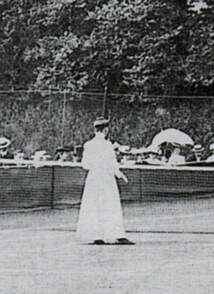 Who was the mysterious lady killed at Ossining Railroad Station in 1906?
February 21, 1906
Who was the mysterious lady killed at Ossining Railroad Station in 1906?
February 21, 1906
She was wearing a steel gray tailor suit with a white shirt wait and black laced shoes with French heels. A fur stole surrounded her neck, and her black hat was trimmed with two black plumes and a white feather. Her hands were shapely and the nails were well kept. On her fingers she wore two rings, one with a pearl and the other with five sapphires surrounded by diamonds. Her dark auburn hair had three gold and amber side-combs in them, and she had dark eyes. The majority of her teeth were filled or crowned with gold. Her lower teeth were natural.
A beautiful, wealthy stranger that died a horrific death filled the headlines across the country, however despite the publicity no one was quick to step up and give her a name.
Not only was her head severed but the right arm was found between the south and northbound tracks.
It was known that she was struck by the Albany Express that passed through the station at 8 p.m. the evening before. Blood was splattered on the pilot of the engine when it arrived at the Grand Central Station. When the body was struck, the train was traveling at such a high rate of speed that none of the passengers or the crew noticed.
 Sing Sing Prison c.1880s The auburn-haired lady arrived on the noon train at Ossining from the city. She was seen hurrying up the hill in the direction of the prison. Her unusual good looks caused her appearance to be remembered. A hackman said she carried a small handbag held by a gold chain. After she vanished up the hill no one in the town could remember seeing her again.
Sing Sing Prison c.1880s The auburn-haired lady arrived on the noon train at Ossining from the city. She was seen hurrying up the hill in the direction of the prison. Her unusual good looks caused her appearance to be remembered. A hackman said she carried a small handbag held by a gold chain. After she vanished up the hill no one in the town could remember seeing her again.Conductor Newhouse stumbled over the body at about 9:30 p.m. There was no evidence of her reticule. Her jacket was gone as well as the arm that had been ripped from the body.
The absence of her purse led the police to believe it was a case of murder, and the officials at the prison did not remember her visiting at all. State Detective Jackson said he was positive the woman never came to Sing Sing prison as a visitor. So why was she there?
Where she was found was halfway between the station and the north gate of Sing Sing prison, which was the last place a woman would be found at night. The New York Central tracks lay between the Hudson River, and a rocky cliff 70 feet straight up to the winding prison road.
"To reach there otherwise than by dropping off a train the woman must have walked or been carried through the maze of tracks in the freight yards and past the station or else been put ashore from a boat."
James Gallagher, the towerman, only 100 feet away from the scene saw no pedestrian in his vicinity that night.
The body was taken to Ramsdall's Morgue where the coroner, John F. Sellick would make his investigation. There was no wound on the body except by the neck where it had been severed. She was about 5'3" to 5'6" and weighed about 150 pounds. Her age was estimated to be about 25 to 35 years.
While she was at the morgue, many of the townspeople came by to see her, and no one recognized her features.
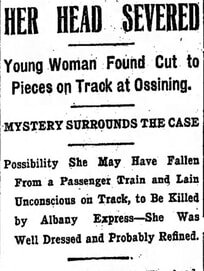 The mystery of the Lady of Ossining made the headlines across the country Soon there was a theory that the woman at the tracks was Mrs. Durwood H. Martin, since she matched the description of the lady on the tracks.
The mystery of the Lady of Ossining made the headlines across the country Soon there was a theory that the woman at the tracks was Mrs. Durwood H. Martin, since she matched the description of the lady on the tracks. The villagers wondered about the action of a woman dressed in purple who visited the prison, and then was seen at the Weskora Hotel and in George Dempsey's saloon. She wrote several letters at the hotel, and said she was the wife of a man named Martin who kept a restaurant on Broadway opposite the Hotel Astor. She was last seen the evening before the dead woman's body was found. Her husband's restaurant had been burned, and he fled to to Mexico after getting in trouble over a check. He had returned only a short time before. He was arrested, pled guilty and was sentenced to Sing Sing Prison.
The police believed there was no connection between the two women, however any hope of identifying the dead woman was not discounted.
The hopes were dashed when on February 25 , Mrs. Martin communicated with her relatives to say she was very much alive and staying in Schenectady.
There was another theory where it was believed the lady fell from a passing train which explained why she was not wearing a coat, gloves or had a handbag. Perhaps she was passing from one car to another and fell between the cars.
Was the Lady of Ossining a victim of murder, accident or suicide? Her name along with the answer to that question remains unknown.
Published on December 06, 2022 08:00
November 28, 2022
The Dry Bones
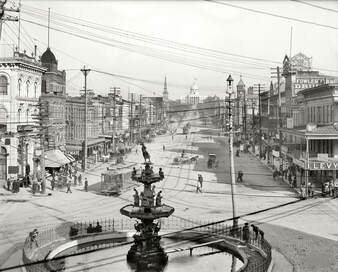 By M.P. Pellicer | Stranger Than Fiction Stories
By M.P. Pellicer | Stranger Than Fiction StoriesIn May, 1875, in the city of Montgomery, Alabama in an old building on the corner of Market and Lawrence Streets what was described as "a poor perturbed spirit" made its presence known.
 Court Square & Market St. Montgomery, Alabama c.1867
Montgomery, Alabama 1875
Court Square & Market St. Montgomery, Alabama c.1867
Montgomery, Alabama 1875
It was one of the oldest building in the city, and the upper floors were once occupied by The State Journal printing office. It stood opposite to the Montgomery Hall.
This space was taken over as a flop house, and the lower floor was a large hall known as Freely Hall, used also as a carriage and wagon repository, and a bar room.
The whole building was very dilapidated.
Persons passing through this area said they felt a peculiar sensation as if they were by themselves in a graveyard.
About 8 o'clock those living upstairs heard a strange noise in the hall below.
"Some of them put their heads through the holes in the floor of their room where panels were missing." They thought they were being robbed.
They called out, "Who's that?"
Several voices shrieked out, "Who is you, I say?" then the clanking of chains echoed through the hall. Then it was followed by "low, rumbling sounds, groans, shrieks and a steady tramp, tramp, tramp as though a thousand soldiers were marching to their eternal bivouac."
"Ghosts!" one of the occupants shouted and they left the building, their eyes dilated to the "size and brightness of a Wethersfield onion."
The alarm spread over the neighborhood, Men with guns, women with pokers, and children all gathered to see and catch the ghost. They all told stories about ghosts, but none dared to go near the house.
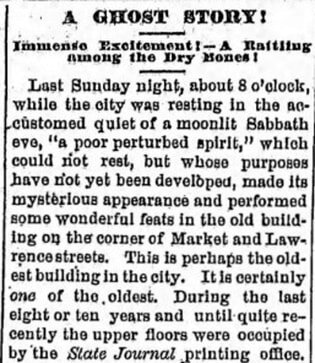 The ghost story that excited Montgomery, Alabama in 1875 Some brave souls eventually went into the halls and returned with stories that the "ghost blew his breath on their cigar, and another said he got close to him and it made a grab at him and his arm went though just he was mist."
The ghost story that excited Montgomery, Alabama in 1875 Some brave souls eventually went into the halls and returned with stories that the "ghost blew his breath on their cigar, and another said he got close to him and it made a grab at him and his arm went though just he was mist." Another said that as he was sneaking in through the window the ghost, "who was standing in the far end of the hall, jerked his own head off and threw it at him, knocking him about ten feet back out of the window."
The ridiculous stories demoralized the crowd who now numbered about 200, and it was finally resolved that it was up to the Mayor and the City Council to run out the ghosts.
Finally one man said that he wasn't afraid of ghosts and if 40 men would follow him he would go in the house and find who was there "dead or alive."
As he finished his speech a big, fat woman standing in the crowd raised her hands above her head and screamed, "Lordy, look a yonder! He's coming out of the window." In a few seconds not a "mother's son or daughter were to be seen in four squares of the place." It was observed that every occupied room in a square of that house had a light burning throughout the entire night.
A few nights later the rumor was that the ghost had reappeared at the same place. A large number people congregated at the corner of the haunted house to watch what would happen.
Again strange sounds and groans were plainly heard. This time the ghost replied to questions from the crowd.
He stated that his name was "Rodgers, and that he was murdered in that building 42 years before and that his family were now in indigent circumstances." He added, "that he was accompanied by the spirit of a woman who was murdered at Mount Meigs before the war." He stopped talking except to say he would return the following night and reveal the whole mystery.
Since the appearance of the the ghost many stories were told of former mysterious appearances in the hall.
Someone had kept a skating rink there several years ago, who said he closed it because he saw at several different times two strange figures passing the hall at night after he closed the doors.
The next day about 2,000 people gathered to witness the third appearance of the ghost. There was no ghost, and mediums said the spirits informed them they would appear if the crowd was smaller and less boisterous.
However, the ghosts didn't keep their word, and the story faded from the newspapers.
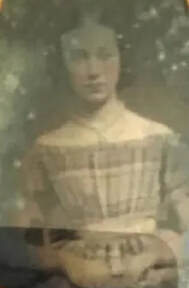 Who was the woman found dead by the railroad track at Knoxville, Alabama c.1857 In 1857, there was a "strong suspicion" that a woman had been killed in Knoxville, Alabama. A "hideous amount of cotton, with pieces of whale bone scattered 'promiscously' around, was discovered" in the neighborhood of the railroad.
Who was the woman found dead by the railroad track at Knoxville, Alabama c.1857 In 1857, there was a "strong suspicion" that a woman had been killed in Knoxville, Alabama. A "hideous amount of cotton, with pieces of whale bone scattered 'promiscously' around, was discovered" in the neighborhood of the railroad.The impression was that a woman was murdered thereabouts. The matter had been kept quiet with hopes of finding clues to the guilty parties The remains were taken to the coroner.
Her identity was never established, much less who did this to her.
The description of what was found by the railroad is just as elusive. What else besides cotton and whalebone was left? Apparently enough to take to the coroner.
If there was ever a reason to haunt, a death like this would be it.
Published on November 28, 2022 08:00
November 23, 2022
Witness to the Forbidden
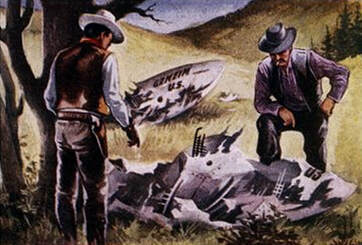 By M.P. Pellicer | Stranger Than Fiction Stories
By M.P. Pellicer | Stranger Than Fiction StoriesMany consider the Roswell incident as the jumping off point for modern ufology. However those who were there at the beginning found that being a witness was more a curse than a gift.
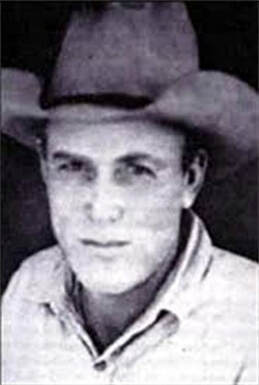 W. W. "Mack" Brazel c.1930s It all started when William "Mack" Brazel, 48, worked as foreman at the J.B. Foster sheep ranch located about 30 miles from the small town of Corona, New Mexico. The Brazel family lived in Tularosa, and Mack stayed in a shack without running water, electricity and a phone. The nearest neighbor was almost a dozen miles away.
W. W. "Mack" Brazel c.1930s It all started when William "Mack" Brazel, 48, worked as foreman at the J.B. Foster sheep ranch located about 30 miles from the small town of Corona, New Mexico. The Brazel family lived in Tularosa, and Mack stayed in a shack without running water, electricity and a phone. The nearest neighbor was almost a dozen miles away.At the beginning of July, 1947, he came across metallic debris spread over the scraggly grazing grounds in an area of about 200 yards. Besides being out of place, he saw that the sheep wouldn't cross the field where the strange material lay.
He packed a box with a sample and told the Chavez County sheriff about his find. Brazel's main concern was to have the area cleaned. Sheriff Wilcox notified the personnel at Roswell Army Air Field.
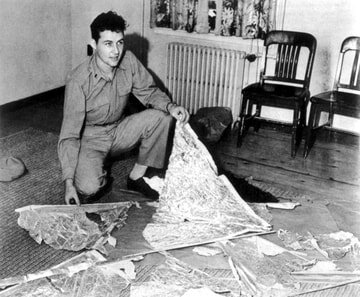 Military publicity pics to discount flying disc story Major Jesse Marcel and Captain Sheridan Cavitt went to view the debris the same day, and take it back to the base by July 8.
Military publicity pics to discount flying disc story Major Jesse Marcel and Captain Sheridan Cavitt went to view the debris the same day, and take it back to the base by July 8.Colonel William Blanchard, the C.O. at Roswell issued a press release that claimed a "flying disk" had been found. No sooner had the press release been sent out then Brig. General Roger M. Ramey, his superior held a press conference in Fort Worth contesting the UFO version and instead describing it "as the remnants of a ray wind target used to determine the direction and velocity of winds at high altitutdes."
By July 9, newspapers were reporting the W. W. Brazel was sorry he had said anything about it. He couldn't understand what all the fuss was about. He said, "If I find anything else short of a bomb it's going to be hard to get me to talk."
Brazel had no idea that there had been reports of flying saucers throughout 43 states for the past several weeks.
However prior to this Mack Brazel had found weather balloons twice on the ranch grounds, and he stated, "I am sure what I found was not any weather observation balloon."
But there was more going on in the background than the conflict of what the debris was. The incident might have faded from the public's attention but those at the center of the discovery had their lives changed forever.
Mack Brazel was placed in military custody at the base between July 7 to 8. Some have wondered if any of the statements after this date were given by a coerced and frightened man. He was the only Roswell witness who was detained by the military. He was described as a man of few words, but his handshake was his bond.
The incident was forgotten until thirty-one years later when Major Jesse Marcel spoke out and said the debris recovered at the ranch was "not from this Earth."
By then Mack Brazel had died in 1963, and his wife Maggie in 1975.
Mack's son, Bill was later interviewed by different ufologists included Stanton Friedman, and he said his dad told him very little about what happened at Roswell, and that he said nothing to his mother either. The only person he thought his father had confided in was his wife Shirley. She died in 1996.
Mack's son believed his father took much of what he knew to the grave. There was no doubt he was bitter about being jailed for a week for what he thought was a good deed. His relatives believed Mack's reticence in sharing his experience is that he was sworn to secrecy for patriotic reasons. Others think that the military threatened his family.
 Were there alien bodies at the Roswell crash site? Mack's youngest child, Vernon was 7 years old when the Roswell incident occurred. In 1958, he was reported to be serving on the fleet oiler USS Hassayampa as a gunners' mate third class in the Western Pacific. It's believed he saw the debris, and possibly alien bodies at the crash site. The incident was said to have affected him profoundly. He left the state as soon as he could, never to return, and it's been reported he even changed his name. He died in 1967 while living in Montana, allegedly by his own hand.
Were there alien bodies at the Roswell crash site? Mack's youngest child, Vernon was 7 years old when the Roswell incident occurred. In 1958, he was reported to be serving on the fleet oiler USS Hassayampa as a gunners' mate third class in the Western Pacific. It's believed he saw the debris, and possibly alien bodies at the crash site. The incident was said to have affected him profoundly. He left the state as soon as he could, never to return, and it's been reported he even changed his name. He died in 1967 while living in Montana, allegedly by his own hand.Another son Paul who worked for the J. B. Foster ranch where his father worked, died in 1997, but denied knowledge of any events.
Mack's neighbors described that prior to his visit to Corona to report his discovery he had been excited and talkative about what he found. When he returned he wouldn't talk to anyone about it, and would just change the subject.
Another neighbor described where he saw Mack surrounded by about 7 military escorts as he walked down the street in Corona.
Even years after the incident Mack's response to any inquiries was terse and short.
In the book The Roswell Incident (1990) it described where Mack said the debris came from an airborne explosion not a crash. The sparse vegetation was singed and the pieces were littered over a large area. The metal was different than anything he knew of which he could not cut, scratch or whittle with his knife.;
Other witnesses said there was strange symbols on the metal. Mack said they looked like wiggles that were in pastel colors.
There has been conjecture if the military's quick response to Mack's find was that this was not the first time they had come across a similar scenario.
Frank Joyce was an announcer for KGFL in Roswell, he was the one that placed the story of Blanchard's description of a "captured disk" on the UP wire. Instead of being a story read only by Roswell residents, it made it around the world. In 1948, he left to Albuquerque never to return. He continued to work in television and radio. During later interview, Joyce, like Brazel was reticent about saying too much. The subject that seemed the most verboten was information about seeing bodies.
Later Mack Brazel would tell close family and friends that letting the military authorities know about the debris field was the worst mistake he had ever made in his life.
Published on November 23, 2022 08:00
November 13, 2022
Who Did Eddie In?
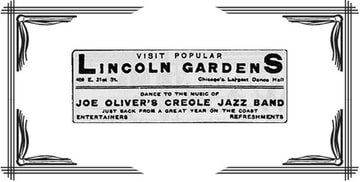 It was a couple of days after the New Year of 1921, when Patrolman Mullen responded to a call at the Lincoln Gardens, one of the largest dance halls on Chicago's South Side. His first mistake was showing up alone.
It was a couple of days after the New Year of 1921, when Patrolman Mullen responded to a call at the Lincoln Gardens, one of the largest dance halls on Chicago's South Side. His first mistake was showing up alone.
 Patrolman John Mullen (1893-1921) Mullen was a block away when the call came in. Siding with precaution he entered by a side door. A large crystal ball hung over the floor, light winking from the small pieces of glass on it. Suddenly a shot rang out.
Patrolman John Mullen (1893-1921) Mullen was a block away when the call came in. Siding with precaution he entered by a side door. A large crystal ball hung over the floor, light winking from the small pieces of glass on it. Suddenly a shot rang out.Doctors tried to save Mullen, giving him transfusions fed by the blood of his fellow officers, but he died on the operating table. He was 27 years old, and a veteran from what was then known as The Great War.
By the time fellow officers showed up the shooter had fled. But they soon knew who they were looking for.
Miss Johnson said to Lieut. Shoemaker from the Chicago Police Department, "We drank ginger ale highballs at the gardens. McBride and Crosby became quarrelsome. They threatened the proprietor. He called the policeman."
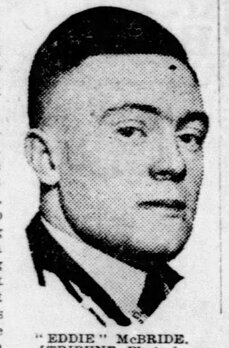 Eddie McBride Within a day the hunt was on and there was a price on the head of Mullen's killer. And what the police wanted was the name of who pulled the trigger.
Eddie McBride Within a day the hunt was on and there was a price on the head of Mullen's killer. And what the police wanted was the name of who pulled the trigger.Patrolman John O'Donnell visited John Hanley at 2256 N Clark St., investigating the crime where Hanley threatened him with a rifle. For his troubles, Hanley got shot in the foot.
The next name that came up was Eddie Morris, alias Foster who was accused by his pal, James Crosby who'd been picked up, as the shooter.
Two rifle squads were scouring the city, and everyone on the force had a photo of Morris. As a sweetener there was a $250 reward for the capture of Eddie McBride who was implicated as the driver of the car in which the killer escaped.
McBride was also said to have driven the car that escaped after a "running battle with a police rifle squad on the south side" the day before.
There was also an attempt to connect Morris with a robbery at the Roling Jewelry Store on Milwaukee Avenue where $18,000 in merchandise was stolen.
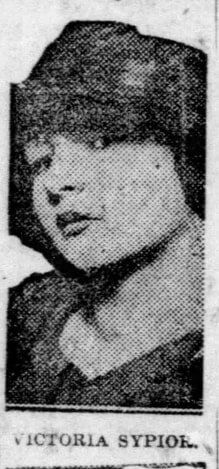 Victoria Sypior Genevieve Johnson, 15, confessed she was a member of the party at the Lincoln Gardens when Mullen's murder took place. Her version of events was corroborated by Clara Heggins, 16, and Victoria Sypior, 16, all companions of Morris at the Gardens and who witnessed the event up close. Two other girls , Mae Roder, and Margaret Burns were also being held as witnesses.
Victoria Sypior Genevieve Johnson, 15, confessed she was a member of the party at the Lincoln Gardens when Mullen's murder took place. Her version of events was corroborated by Clara Heggins, 16, and Victoria Sypior, 16, all companions of Morris at the Gardens and who witnessed the event up close. Two other girls , Mae Roder, and Margaret Burns were also being held as witnesses.Crosby besides giving up Morris and McBride's names, told police they intended to rob the café.
Police were also looking for the wife of Eddie Morris, even though she was not present at Lincoln Gardens on the night in question, but "she was said to have directed many holdups pulled by the two men being sought."
Morris had been wanted since 1919, in connection with a confidence game.
He was pursued from Chicago to Bloomington, and there were rumors that Mullen was responsible for other murders, and that he and McBride were showing up the South Side cabarets, Jeffery Tavern and Beverly Gardens as late as Tuesday night.
 Violet Johnson was engaged to Patrolman Mullen The plot thickens or so they say, and police claimed that Morris was the criminal who killed Joseph Schweitzer a chauffeur, in a daylight raid on a "booze laden truck" at Erie and Halsted Streets on December 31, 1920.
Violet Johnson was engaged to Patrolman Mullen The plot thickens or so they say, and police claimed that Morris was the criminal who killed Joseph Schweitzer a chauffeur, in a daylight raid on a "booze laden truck" at Erie and Halsted Streets on December 31, 1920.Ed Reiden who was riding on the truck with Schweitzer, and who was wounded identified Morris' car as the one used by the whisky robbers.
It turned out the license tag on the auto Morris and McBride escaped was issued to Arthur Ahern, manager of the Jeffery Tavern.
Police were leaving no stone unturned and three young women known as companions of Morris, McBride and other members of the gang were taken into custody. Marie Robbins and sisters, Emma and Clara Haupt were held as witnesses. They had hurriedly left Chicago on Monday after the Mullen's murder.
In the meantime James Crosby was singing like a canary, naming other members of the gang.
One of the witnesses at Mullen's inquest was Violet Johnson was was engaged to the patrolman.
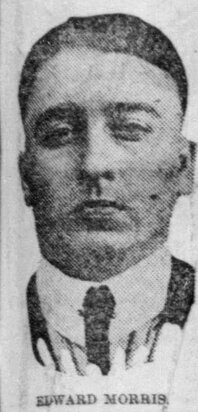 Edward "Eddie" Morris A month later Eddie McBride was captured when detectives armed with shotguns and rifles hunted him down in a rooming house at 1242 West Adams St.
Edward "Eddie" Morris A month later Eddie McBride was captured when detectives armed with shotguns and rifles hunted him down in a rooming house at 1242 West Adams St.He refused to identify himself, and said he was Edward J. McCauley, a machinist who'd just come in from Philadelphia a few days before.
Police brought in the girls accompanying the men as well as employees at Lincoln Gardens who all confirmed he was McBride.
After seven people ID'd him, and he was "grilled" for 12 hours he made a complete confession which of course named Morris as the slayer.
He shouted at Detective Hughes, "Yes, I'm the guy, I'm the guy, all right. Shut up a while and I'll tell you all I know about it."
His confession took up 10 typed pages, but then he refused to sign it.
He said, "I was with Morris on the night of the killing, and was driving the car. I was a pal of Morris. They knew me as Eddie McBride on the South Side, but my real name is McClane. I know Jim Crosby, too. I was with them when Mullen was killed, but I didn't want to squeal on pals."
Then he went on to say he knew Morris, and said, "Sure I got under cover. I lived with a gang of I.W.W.s who were friendly to me, and I pulled a few little jobs to keep me in cash. No, I didn't do the shooting, but I don't want to hang a pal. I was in front of the Lincoln Gardens when the shooting happened. I was sitting in the car with my girl when Eddie came rushing out and told me to drive like hell. 'I just killed a copper!' he yelled at me, and I gave it the gas."
However authorities were not ready to believe he was as innocent as he claimed. They believed he was implicated in the shooting of Sgt. Edward Grim when detectives tried to arrest a band of automobile thieves at 126 Hudson Ave. the year before.
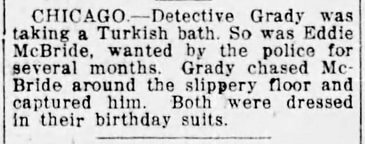 Eddie McBride was captured in a Turkish bath They also believed he was one of th bandits who robbed Richard Farrell a messenger of the West Town State Bank and took a bag containing $2,300.
Eddie McBride was captured in a Turkish bath They also believed he was one of th bandits who robbed Richard Farrell a messenger of the West Town State Bank and took a bag containing $2,300.Farrell partially identified him as the bandit who put a revolver in his face while another grabbed the bag from his hand.
After a little more police persuasion he admitted to saying he had threatened to throw one of the three girls into the river if she told police about the shooting. She had been in the car with him when Morris ran out after shooting Mullen.
A few days later Eddie Morris was captured in a stack of cornstalks a mile west of Beverly Gardens.
Soon after Edward Lieberman, 26, a companion of Morris and McBride was taken into custody. He was wanted for burglary and robbery, and suspected of being connected with a gang of automobile whisky bandits who killed Joseph Schweitzer.
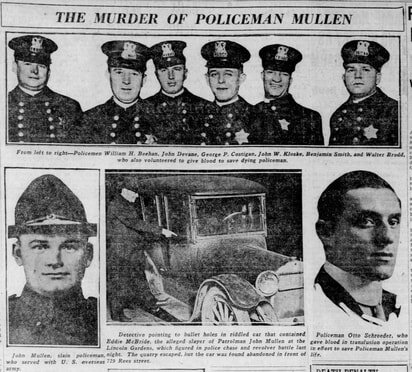 The law advanced at a fast pace and by the end of March, 1921, the trial for the murder of Officer Mullen had come to the courts. Eddie Morris along with Eddie McBride and John McEvilly were charged with the crime.
The law advanced at a fast pace and by the end of March, 1921, the trial for the murder of Officer Mullen had come to the courts. Eddie Morris along with Eddie McBride and John McEvilly were charged with the crime.Morris took the stand on his own behalf and said he was so drunk while at the gardens he didn't know if he fired his revolver or not.
An attorney for the state asked him, "Did you have any liquor?" He answered, "Yes, I was out on a rum deal with a policeman and a man named "Bull" Taylor. They gave me four pints."
He answered the question, but also implicated the police in illegal activity. Most of his responses involved that he didn't remember because he was too drunk.
Dr. Elizabeth Wells a psychologist from the juvenile court testified that Victoria Sypio, the 16-year-old factory girl who was a state witness, was only 10 and a half years old mentally.
The state was asking for the hangman's noose for the men. Apparently the police were called when the checkroom girls ran to John Balash the manager saying, "A mans' trying to stick up the place."
On March 28, 1921, Morris was found guilty of the murder of John Mullen, and he was sentenced to life imprisonment to be served at Joliet Prison. McEvilly and McBride were found not guilty.
However McBride's freedom was short-lived. In May he was arrested at the request of California authorities. They identified him as Clarence Kelly who escaped from prison a year ago after being convicted of holding up a man in San Francisco. They wanted him back at San Quentin to serve out seven years of a ten year term.
Eddie boasted after the arrest, "If they get me back there it means seven years of solitary confinement. That would mean the box for me. I'd be dead in less than five years. Not for me."
His guards were warned to keep a "wary eye" on him, however he managed to free himself some way from leg irons and shackles he'd been wearing since he left Chicago. McBride leaped from the train as it slowed down in the suburbs of Los Angeles.
The authorities could not find him.
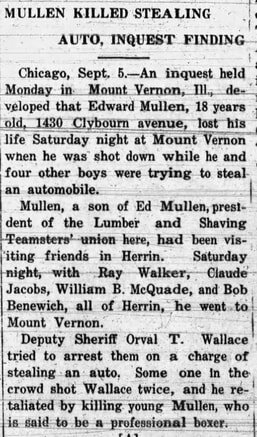 Edward Mullen was killed in September, 1922. The search for Eddie McBride faded from the headlines. However the Mullen family found themselves once more facing a sad situation.
Edward Mullen was killed in September, 1922. The search for Eddie McBride faded from the headlines. However the Mullen family found themselves once more facing a sad situation. It was September, 1922, when their 15-year-old son Edward Mullen joined up with four other men out in Mt. Vernon. They stole an auto belonging to Clyde Hunter of Herrin. They drove to Bonnie where it broke down. Harry Bumpus' garage was the perfect place to find a replacement, and they stole another car. As soon as the men drove away Bumpus called the police, who caught up with the thieves outside of town on a country road.
Deputy Sheriff Orval T. Wallace tried to arrest them on a charge of stealing an auto. Someone in the crowd shot at Wallace twice and a gun battle broke out. Wallace returned fire killing Ed Mullen who was hit in the side and chest. Claude Jacobs, one of the gang members was arrested, and the rest fled into the countryside. Bloodhounds were brought to hunt them down.
In less than two years, the Mullen family had lost two sons.
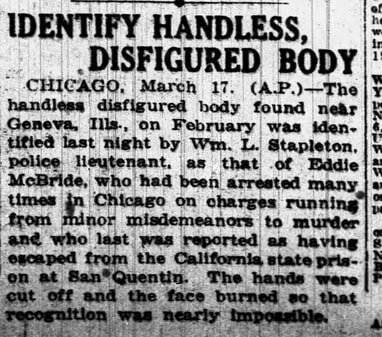 The death of Eddie McBride? A few months later, on a stormy night on February 13, 1923, Robert Johnson a farmer traveling on a sleet-covered road west of Geneva came across what was left of a man.
The death of Eddie McBride? A few months later, on a stormy night on February 13, 1923, Robert Johnson a farmer traveling on a sleet-covered road west of Geneva came across what was left of a man.The body was nude and covered by snow. The hands were missing and the body especially the face was terribly mutilated since it was burned.
The body was held at Skoglund Undertakers for a month, until it was was determined that the "mystery man" was Eddie McBride, described as a "Chicago gunman, escaped convict and bootlegger." Lieutenant W.L. Stapleton of the Maxwell Street Station identified him.
When asked for his theory of the murder, Stapleton said, "There could easily be construed a motive for the killing of Eddie. It was McBride who became a police informant two years ago and enabled us to capture Eddie Morris for the murder of Patrolman Mullen. Morris went to the penitentiary for life and his pals swore to get even with McBride for squealing. He may also be the victim of a bootlegger's war. We learned that McBride was back in Chicago about two months ago, engaged in bootlegging."
He continued, "Any of Edward Morris' friends might have killed him in revenge for his information against Morris, and of course, McBride who was a police character, could easily have been identified through fingerprints or from facial appearance. Therefore the killers destroyed the hands and the features."
 Was Eddie McBride the mutilated man found dead in a snow grave? So who killed Eddie McBride? Was it bootleggers in revenge for his betrayal of Morris, or even the police who wanted justice for the murder of a fellow officer? Or perhaps it was the hand of Edward Mullen Sr., who was the President of the Lumber and Shaving Teamsters' Union, who wanted to make sure the killer of his son was punished, and didn't trust the justice system to mete it out. He followed his sons to the grave in 1926, at the age of 53.
Was Eddie McBride the mutilated man found dead in a snow grave? So who killed Eddie McBride? Was it bootleggers in revenge for his betrayal of Morris, or even the police who wanted justice for the murder of a fellow officer? Or perhaps it was the hand of Edward Mullen Sr., who was the President of the Lumber and Shaving Teamsters' Union, who wanted to make sure the killer of his son was punished, and didn't trust the justice system to mete it out. He followed his sons to the grave in 1926, at the age of 53.What if the man found in his snowy grave wasn't Eddie McBride at all? The remains were identified on the strength of Lieutenant Stapleton's word only. There were others who said the body didn't fit with the description of McBride.
The mystery remains as to who did away with McBride, and if it was even McBride to begin with. Perhaps Eddie in a rare moment of wisdom, moved on to greener and safer pastures.
Published on November 13, 2022 08:00
November 12, 2022
The Phantoms of Oxford
 By M.P. Pellicer | Stranger Than Fiction Stories
By M.P. Pellicer | Stranger Than Fiction StoriesA university dorm, once an asylum spawned an enduring mystery of a missing student, that until this day remains unsolved.
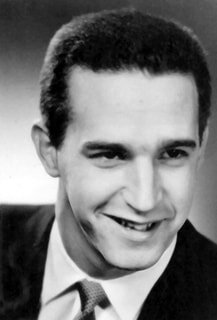 Ron Tammen Jr In 1953, Ronald Henry Tammen Jr. was attending Miami University as a sophomore. He played string bass in the University dance band known as the Campus Owls, he was part of the Delta Tau Delta fraternity, he was a member of the wrestling team, and he was enrolled in the Navy ROTC program. Ron drove a 1938 Chevrolet, and he was the picture of a prototypical university student of the 1950s.
Ron Tammen Jr In 1953, Ronald Henry Tammen Jr. was attending Miami University as a sophomore. He played string bass in the University dance band known as the Campus Owls, he was part of the Delta Tau Delta fraternity, he was a member of the wrestling team, and he was enrolled in the Navy ROTC program. Ron drove a 1938 Chevrolet, and he was the picture of a prototypical university student of the 1950s.His younger brother Richard also attended the university as a freshman.
On April 19, 1953, at 8 p.m. he left Room 225 in Fisher Hall to get new bedsheets because his friend Richard Titus had put a fish in his bed as a prank. Richard was in room 212, just a few feet from Tammen's dorm room. The hall manager gave him clean sheets, and he was the last person to see Tammen at 10:30 p.m. that night.
The identity of the prankster was not verified until 2010 by J. Wenger who runs a complete blog about the Tammen story. She points out that Titus slipped the dead fish into Tammen's bed on Saturday night. It seems that the night before he disappeared, Ron did not sleep in his bed at the dorm, and it wasn't until Sunday when he discovered the "corpse" hidden among his sheets.
Later his roommate Charles Findlay came to their room around 9 p.m. He had spent the weekend at his Dayton home. He found Tammen's psychology book open on his desk, the radio was playing and the lights in the room were blazing. The door to the dorm was unlocked.
The roommate did not think anything sinister, and thought Tammen had gone to spend the night in the Delta Tau Delta house. Strangely though Tammen had left his coat behind even though it was a snowy night. Also his wallet, school ring and car keys were in the room.
Visible from the window of the dorm was Ron's 1938, gold Chevy with his bass fiddle in the back seat. Both of these were cherished possessions, which apparently were left behind as well.
Only when Ron failed to appear the following day was a search initiated. A nearby pond was dragged. His parents and the police were not notified until April 23.
A week after his disappearance 400 students walked 3 miles in each direction as part of a search effort, but nothing came of it.
One witness, a Mrs. Spivey said that a dazed young man with a streak of dirt on his face, fitting Tammen's description came to her home at Village of Seven Mile early on the morning of April 20, asking for directions to the nearest bus stop. However she did not come forward with this information until June, and later on there was a question how accurate she was.
By May 18, the FBI had joined the hunt for Ron Tammen after the draft board was notified by his father that he was missing. Once he was not attending the university, his deferment would end. His parents were hoping that they would help to distribute their son's likeness across the country.
Oscar Decker the Oxford police chief said, "He's probably alive and quite healthy, but maybe hundreds of miles away where no one has recognized him." Again this was based on the theory that Ron was an amnesiac.
No doubt there were some that wondered if Ron had been a victim of a hazing gone wrong. Others felt the police investigation had not been adequate.
Ron's room was at the end of a hallway, where hardly anyone passed by, and it was close to a fire escape. Was it coincidental that if something nefarious was planned it was done when his roommate would be away for the entire weekend?
Two years passed, and the local newspapers ran a short story reminding everyone that Ron had yet to be found. His parents were interviewed at their Maple Heights home, and they said they believed he was still alive.
Hopes were stirred in 1958, when bones were discovered by workmen in a gravel pit near West Alexandria, Ohio which was 25 miles from Oxford. A complete set of teeth with no fillings were recovered from the body. Mrs. Tannen said her son had several teeth filled.
In 1967, his mother Marjorie passed away. His father remarried and moved to Florida.
Throughout the years, there have been supposed sightings of Ron, including those much closer to home where some say he haunts the campus he disappeared from.
In 1967, a spiritualist ceremony was held at Fisher Hall where a séance was scheduled. John T. Lilley from Dayton would be conducting it on a full moon night. The hall seated 200 persons, but the event became so popular that it was decided they should start to accept telephone reservations for a ticket.
Another attempt for spirit communication was made in 1975, not only to see if Ron would come forth, but also to see who else was haunting the building. The medium described where a young man heard a noise that drew him to the basement and he encountered two men. One of them struck him from behind. No other information came after this scene. This left everything just as mysterious as before.
In 1973, the Butler County Coroner said that Tammen visited his office 5 months before his disappearance asking for a blood test. The coroner thought this was a very unusual request.
Fisher Hall was demolished in 1978, and an extensive search was made of the rubble, nothing connected to Ron Tammen was found including his remains.
Some students went on to dub him the Phantom of Oxford.
In 2009, a DNA sample was taken from his sister and compared to a John Doe body found in 1953, in Georgia, however there was no match. Ron's sister passed away in 2020, his parents have also died as well as two of his other brothers. Only one brother is left who lives in Florida.
Born in 1933, if Ron were still alive he would be in his 80s. It seemed that if he did go on to live a life under an assumed identity, he never did anything which would require him to submit his fingerprints, such as an arrest or a job. It seems as if the earth swallowed Ronald Tammen Jr. whole.
Then there was story of a ghost being seen in the formal gardens behind Fisher Hall. Then the ghost was heard singing, however if anyone chased it, the phantom would just disappear.
Some believed it was Ron's phantom, others thought it was a prank, and then others wondered if someone played a practical joke on Ron that went too far.
A few years after Ron's disappearance the upper floors of Fisher Hall were left untenanted because they were unsafe. The first floor was used for the university's theater. The students all said there was a ghost there.
Items would disappear, and many were afraid to stay alone in the building. Shadows passed swiftly behind the windows, and once in a while muffled voices were heard, but what was being said could not be made out.
Eventually the entire building was deemed unsafe and it was only used for storage.
Students would remark that when passing by the building they would feel someone watching them.
Fisher Hall was razed in 1979, and in its place the Timothy Marcum Memorial Conference Center was erected. It was named after Joseph Timothy Marcum who graduated in 1973, and died in a one-car crash in July of that same year.
 Henry Snyder a professor at Miami University who committed suicide in 1898. However Oxford College had mysteries and ghost stories long before Ron Tammen Jr. disappeared.
Henry Snyder a professor at Miami University who committed suicide in 1898. However Oxford College had mysteries and ghost stories long before Ron Tammen Jr. disappeared.Old Fisher Hall was once the Oxford College for Women. In the 1880s, Dr. Harvey Cook bought the building and made into an asylum and sanitarium after it closed. He added other buildings and it was then called the Oxford Retreat. There was also the acquisition of a building that was named The Pines, and Dr. Cook lived at an adjacent structure called Cook Place.
There was a tunnel that led from The Pines to Cook Place. The story told about the tunnel, is that Dr. Cook used it get to his house from the Pines without being seen by the patients.
Miami University first acquired the Retreat property in 1925. The old college building was renamed Fisher Hall, and was used as a residence for the male students. Every once in a while the students would come across discarded strait jackets and other remnants of what the building was once used for.
According to When the Ghost Screams: True Stories of Victims Who Haunt (2006), Fisher Hall already had a reputation for being haunted. The structure had been occupied since 1856, when it was a female college with a dining room which seated 800 students. Two hundred students lived in the building.
During World War II, it was used as a barracks for the Naval radio training school.
 Brice Hall where chances are the chemicals that killed Prof. Snyder were concocted It was September 14, 1898, when Professor Henry Snyder died at his home. There were whispers of suicide, but none could figure out why he would have done away with himself.
Brice Hall where chances are the chemicals that killed Prof. Snyder were concocted It was September 14, 1898, when Professor Henry Snyder died at his home. There were whispers of suicide, but none could figure out why he would have done away with himself.The coroner determined that Professor Snyder was "eccentric" and his death was a case of "suicide beyond doubt."
He had experienced trauma early in his life when he was 9 years old. In 1865, his mother Amanda died during childbirth of her last baby, Charles.
Dr. Harvey Cook from the university analyzed what poisons Snyder had taken, however at the inquest a month later he was unable to identify which drugs caused his death.
The widow, Hermine Snyder nee Meiser, 38, was asked to give testimony at the inquest about what she knew concerning her husband's death.
She confirmed they were married in 1884, and that he had been connected to the university all those years. He was the Chair of the Physics and Chemistry Department. Hermine said his health declined in the last 8 years, but six weeks before his death he had a sunstroke which affected him badly.
Coincidentally Professor Snyder had inherited a considerable fortune some months before upon the death of an uncle at Springfield, Ohio. The family was well off, and two uncles had died in 1896, William and John. Neither were married or had offspring.
Professor Snyder had gone to Springfield almost two months before his death to oversee the erection of a monument over his uncle's grave, which is when he became ill. Which one of the uncles is not certain.
Mrs. Snyder testified that he had been despondent. She had even asked Dr. Alexander, a friend to approach him, which he did by visiting his laboratory in Brice Hall, however Snyder refused to unbolt the door.
David Snyder, Henry's brother was also questioned, and he concurred that his brother had not been in his right mind the last few weeks of his life.
Professor Snyder had gone to Brice Hall where he taught, before he returned to his home and died. He refused to have a physician called. Some wondered if when he visited his laboratory he had concocted the strange chemical that took his life.
Later Dr. Alexander, Dr. George and Harvey Cook all used a stomach pump to wash out his stomach, but nothing worked.
Then there was his wife Hermine, nicknamed Minnie who was so different from him. While he was staid, she dressed like a gypsy who loved to sing on stage. Could she have done away with Professor Snyder? Some said no, but then she went on to marry her husband's lab assistant William Pugh in 1904.
He left her in 1919, destitute and without any knowledge of where he went to. Perhaps by then she had run out of any money she had inherited from her first husband. She died in 1940.
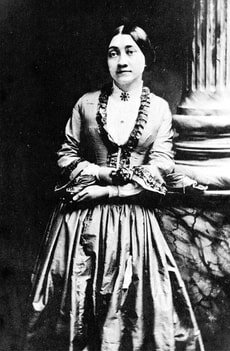 Helen Peabody who died in 1905, is said to haunt Peabody Hall in Miami University For 30 years, Helen Peabody was the president of the famous Western College for Women at Oxford, Ohio. She was known to be stern and unbending, and any boys trying to slip on campus knew they faced a dragon who believed proper young ladies didn't spend time with boys, unless they were chaperoned. She was vehemently against coed education.
Helen Peabody who died in 1905, is said to haunt Peabody Hall in Miami University For 30 years, Helen Peabody was the president of the famous Western College for Women at Oxford, Ohio. She was known to be stern and unbending, and any boys trying to slip on campus knew they faced a dragon who believed proper young ladies didn't spend time with boys, unless they were chaperoned. She was vehemently against coed education.She died on October 8, 1905, in Pasadena, California, and Seminary Hall built in 1855, was renamed for her that same year.
Miss Peabody had resigned as president in 1889, and traveled to Japan on mission business. She returned and relocated to Pasadena, however despite her absence, her body was shipped back and interred in a cemetery in Oxford, Ohio.
She left no immediate family except nieces and nephews, and her estate worth $50,000 which included different properties were to be used to found a home for Christian workers in foreign and home missionary fields.
Students claimed that it's her ghost that haunts Peabody Hall. Low growls are heard, also reports of the shower turning off by itself. A large portrait of Helen dominates the foyer, and many claim the painted eyes follow you as you hurry along.
 Roger Sayles (1938-1959) Reid Hall is also said to be haunted. Footsteps are heard in empty rooms and bloody hand prints were seen on a door. Supposedly the prints will not wash away, and were made many years ago by a student shot and killed when he tried to break up a fight.
Roger Sayles (1938-1959) Reid Hall is also said to be haunted. Footsteps are heard in empty rooms and bloody hand prints were seen on a door. Supposedly the prints will not wash away, and were made many years ago by a student shot and killed when he tried to break up a fight.Two boys once experienced what they called a small earthquake that was only felt in their room.
On May 9, 1959, Herbert A. Lucas, 18, was being searched for by the police. Earlier in day he came to the dormitory at Reid Hall looking for another student named James Walker, 18. There was a dispute over a Sandra Epps, 18, a freshman from Greenville who both young men had dated.
Roger T. Sayles, 20, also a dormitory counselor like Ron Tammen came to quiet the students. Then Herbert Lucas pulled a .22 caliber automatic and fired at Walker who was wounded, and then shot Sayles dead.
Sayles was affiliated with Sigma Alpha Epsilon fraternity and Delta Sigma Pi business fraternity. His reward for being a peacemaker was death.
 Herbert A. Lucas c.1957-58 Lucas was later found in a telephone booth at Ogden Hall where he shot himself in the head. He was carrying two stolen .22 caliber automatic pistols with 250 rounds of ammunition. He had gained entry into the indoor rifle range by breaking in through the roof.
Herbert A. Lucas c.1957-58 Lucas was later found in a telephone booth at Ogden Hall where he shot himself in the head. He was carrying two stolen .22 caliber automatic pistols with 250 rounds of ammunition. He had gained entry into the indoor rifle range by breaking in through the roof.In a heartbreaking turn of events, Sayles' mother was visiting him for Mother's Day and had been staying at the campus.
 Mary Ann Higgins, c.late 19th century, with her son John Henry Higgins Another ghost story that circulates at Miami University is the story of a young Oxford man who was decapitated by barbed wire stretched across a road. He ran through the wire while riding his motorcycle.
Mary Ann Higgins, c.late 19th century, with her son John Henry Higgins Another ghost story that circulates at Miami University is the story of a young Oxford man who was decapitated by barbed wire stretched across a road. He ran through the wire while riding his motorcycle. The story goes that he was traveling on Oxford-Milford Road, on the way to visit his girlfriend who lived on Earhart Road. He is said to repeat the ride that he is never destined to finish. To see him one would go to Earhart Road, and park facing south. If you flash your headlights three times, you may see the motorcycle headlights which suddenly disappear as they approach the fatal curve.
There is no record of this incident occurring at this place or the way described. It's probably an urban myth.
Likely the story was based on the death of George Higgins. On June 21, 1911, he was instantly killed when he ran into a barbed wire stretched across the main road near Colby, Kansas. The wire caught him below the chin. He was riding tandem with another man named Charles Quick who was also badly cut, but would eventually recover. They were traveling at a high speed and it was believed the wire was put across the road maliciously. They were on their way to Atwood near Jim Campbell's farm.
Higgins was the custodian of the school buildings of Colby and Quick, and was formerly the Clerk of Thomas County.
Within a week it was discovered that the barb wire was stretched across the road by a boy, at the direction of a farmer in the area who made it his custom to stretch the wire, while driving the stock from one pasture to another.
The boy would have taken the wire down within another five minutes. The repercussions of that ill-fated day went on to claim other lives. Higgins was a man in his 40s, and had a 22-year-old son. His wife Mary Ann was an invalid, and she died the following year. It was described she arose on a Sunday morning to prepare breakfast, and suddenly fell over dead. Many believed the grief of her husband's death contributed to her collapse.
Charles Quick the tandem rider survived and by 1913, was back on a motorcycle. He made the papers because he broke down out on a country lane, and the story recalled how he barely escaped with his life only two years before. By 1914, he was working for the Twin City Tractor Company, and went on to live many more yeras.


 Harry Thobe c.1940 Harry Thobe was a brick mason born in 1870, and during his lifetime became notorious for gate crashing different sports events, including 20 World Series games, 8 Rose Bowls, 3 Orange Bowls and a Sun Bowl, of course without paying.
Harry Thobe c.1940 Harry Thobe was a brick mason born in 1870, and during his lifetime became notorious for gate crashing different sports events, including 20 World Series games, 8 Rose Bowls, 3 Orange Bowls and a Sun Bowl, of course without paying.He sported a white suit and hat, and diamond-studded teeth. Thobe also carried an umbrella and megaphone. In other words he was unmistakable.
He claimed he attended 54 Miami University Homecoming games, consecutively.
In 1900, he won $150 on that year's election. He hired bands and exploded fireworks and set fire to a huge pile of boxes and barrels in Oxford's public square.
Thobe claimed that the outcome of Miami games would come to him in a dream. Then he would announce it through his megaphone on gameday.
He "designed, donated and built" a fountain for the Miami's campus. The fountain was used to duck "overfresh Freshmen", and the administration was forced to fill it with rocks.
After his death in 1950, it fell into disrepair, and a smaller one was put in its place. This replacement was removed in 1959, and a plaque and monument was erected to commemorate Harry's gift.
If there was something about Harry is that he didn't like to be overlooked. Stories are that his spirit still hangs out by the site of the fountain, which is between King Library and Harrison Hall. All you have do is call out his name, and he'll echo his name back to you.
Published on November 12, 2022 08:00
November 1, 2022
The Devil You Know
 By M.P. Pellicer | Stranger Than Fiction Stories
By M.P. Pellicer | Stranger Than Fiction StoriesHis face is chalky, with eyes as dark as his mustache. The mouth is open below nostrils blackened from cigarette smoke, and you call him Uncle.
 Tio devil depicted in a mine in Potosi, Peru According to this tradition, hundreds of these devils are found throughout mines in South America.
Tio devil depicted in a mine in Potosi, Peru According to this tradition, hundreds of these devils are found throughout mines in South America.He is covered with varied adornments, sitting on a throne with hands extended to receive his due. The feet are shod in rubber mining boots. Hard to miss is his erect penis to remind those who come before him of his virility. This devil's kingdom is Bolivia's tin mines, even though no miner will refer to him as supay which is the Quechua word for devil. Instead the more familial tio, Spanish for uncle is used.
Tio protects miners from accidents as they work in the deep, black holes, but he can also bring harm. Part of his allure is that he can bring prosperity in the quest for veins of tin and silver. In order to placate Tio to both avert disaster or for his generosity homage is paid him through Pachamama.
What he is given depends on the day of the week. Coca leaves, hand-rolled cigarettes on Tuesday and Friday, accompanied by white rum to quench his thirst.
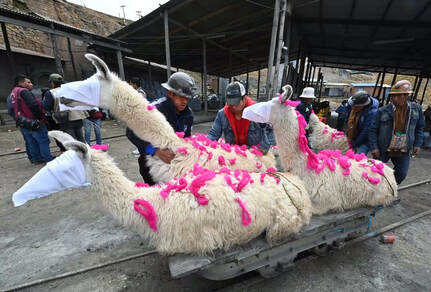 Sacrificial llamas meant to appease the devil El Tio by Bolivian miners (Source - Aizar Raldes AFP) The miners perform cha'alla each carnival Tuesday, pouring the earth around his image with chicha which is rum or beer. He is surrounded by food, and confetti garlands are draped around his neck.
Sacrificial llamas meant to appease the devil El Tio by Bolivian miners (Source - Aizar Raldes AFP) The miners perform cha'alla each carnival Tuesday, pouring the earth around his image with chicha which is rum or beer. He is surrounded by food, and confetti garlands are draped around his neck.On day before August 1 comes the toast of K'araku, where a llama is sacrificed. The animal's blood is poured on the threshold of the mine, and the rest is splattered on the walls. Some miners smear their faces with the blood as well, taken from the still-beating heart of the animals. This is considered good luck.
This ritual is performed by yatari or indigenous witch doctors once a year in February or March, on the eve of the street parade of the Oruro carnival. It is one of Bolivia's biggest festivals, and is listed by UNESCO as an "intangible cultural heritage."
The llama's heart once removed is placed at the statue's feet. After this everyone must leave the mine so El Tio can enjoy his meal, since the blood and hearts of the animal are his favorite meal.
Another blood sacrifice known as wilancha is performed differently. The miners "take a live llama and place it in a mining cart with offerings impregnated with alcohol and kerosene," lighting it as it enters the depths of the mine. The animal is incinerated alive, and afterwards consumed by the participants. What is left is buried as part of the "payment" to Tio and his mine. The offerings are supposedly meant to repay the earth for the minerals taken by the miners.
Carnival time is when El Tio Diablo leaves the mines, disguised as Lucifer where he dances with other demons.
Women are strictly forbidden from entering a mines or participating in ceremonies, as there is a fear the veins of minerals will disappear.
Even women who have lost their husbands in mining accidents, and known as palliris must work outside the mines when they scavenge anything.
The Tio Devil is found throughout the mining districts of the central Andes. The muqui, similar to the the Tio is found in Peru's Ticlio, Morococha, Cerro de Pasco and other mines. The muqui must also be appeased in order to receive his protection.
Despite the offerings made to the Devil Uncle and other similar demons, in the Cerro Rico mountain in Potosi, 8 million men have died there since the mid-1500s. The belief is that if El Tio is not fed, he will feed on human flesh, so it appears he is a hungry devil.
Statues of a Tio are found throughout the mines, where miners go and sit with the idols to keep him company, since he doesn't like to be left alone.
Despite the miners identifying as Catholic, most of them believe that God cannot be found in the depth of the mines. Only El Tio can protect them as they scramble down narrow passages into the bowels of the earth.
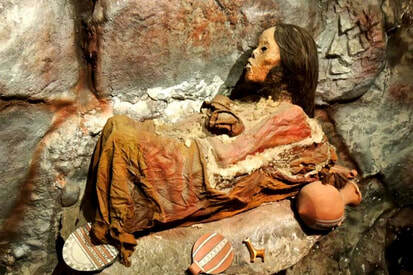 The Juanita Mummy AKA The Lady of Ampato The sacrifices made to El Tio recall the earlier religious ceremonies from the Inca Empire prior to the arrival of Europeans, known as capacocha.
The Juanita Mummy AKA The Lady of Ampato The sacrifices made to El Tio recall the earlier religious ceremonies from the Inca Empire prior to the arrival of Europeans, known as capacocha.In the 1990s, remains of sacrificed children victims were found on the Ampato and Pichu Pichu volcanoes in southern Peru.
Three bodies were found at Ampato at 19,000 feet. The Pichu Pichu capacoha were on a constructed platform at 18,000 feet.
Capacochas were done to bless shrines, in response to catastrophes and to celebrate major construction activities especially if it involved irrigation. The rituals were also performed annually at the Temple of the Sun in Cusco.
 Individual with elongated skull found at Pichu Pichu The victims were young virginal women or children who had no imperfections. However there has been evidence that children sacrificed suffered from serious diseases.
Individual with elongated skull found at Pichu Pichu The victims were young virginal women or children who had no imperfections. However there has been evidence that children sacrificed suffered from serious diseases. In an expedition that lasted from 1995 to 1999, a total of 20 persons were found ranging in age from 3 to 15 years of age. The method described for the sacrifice of the children was by a blow to the head, buried while alive, removal of the heart or strangulation.
One of the remains found at Pichu Pichu displayed cranial modification in an oblique manner done since infancy which caused elongation.
Mass sacrifice of children predate the Incas. In Chimu in northern Peru, 137 children, aged 5 to 14 years were burned alive sometime between 1400 to 1450 AD. There was evidence some had their hearts removed.
The deity Pichu Pichu is a diety that shepherds make offering to in order to gain his protection for themselves, and their herds.
Other studies point out that some of the ritual massacres in the Andes range back to pre-Inca times, but their numbers and sophistication increased with the expansion of the empire from its capital Cusco. These studies indicate that Capacocha (sacrifices of children) was used as a means of social control. According to these, the tombs acted as warnings designed to instill fear in the conquered peoples.
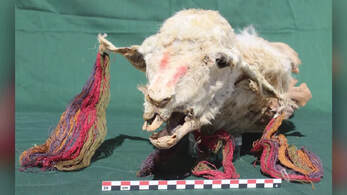 The sacrificed animals were adorned with colored string earrings and necklaces. (Source - L.M. Valdez) In 2018, four llama mummies were discovered under the floor of a building. They were ritually sacrificed at the beginning of the 15th century. The site is known as Tambo Viejo. Three white llamas were killed to appease the sun god, and one brown llama to the creator god. Several dozen guinea pigs were killed as well.
The sacrificed animals were adorned with colored string earrings and necklaces. (Source - L.M. Valdez) In 2018, four llama mummies were discovered under the floor of a building. They were ritually sacrificed at the beginning of the 15th century. The site is known as Tambo Viejo. Three white llamas were killed to appease the sun god, and one brown llama to the creator god. Several dozen guinea pigs were killed as well.For the Incas, llamas were only second to human beings in their value as sacrificial offerings. Radio carbon dating of the four animals date the remains to between 1432 to 1459. They were not cut or stabbed so researchers believe they were buried alive, as was done to humans who were sacrificed.
Intact discoveries like this one confirm accounts of early Spaniards in South America which described that the Inca sacrificed animals by the hundreds. MAN CLAIMS HE WAS OFFERED AS A SACRIFICE AT PACHAMAMA FESTIVAL IN BOLIVIA
Published on November 01, 2022 08:00
October 24, 2022
The Crocodile Hunters
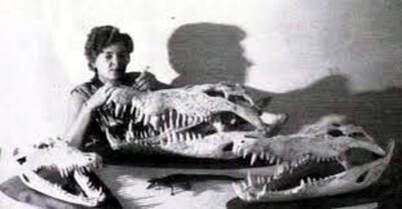 Krystyna "Krys" Pawlowski at first glance would be the most unlikely crocodile hunter you could imagine, however in 1957, she nabbed an Australian saltwater crocodile which was said to measure 28 feet.
Krystyna "Krys" Pawlowski at first glance would be the most unlikely crocodile hunter you could imagine, however in 1957, she nabbed an Australian saltwater crocodile which was said to measure 28 feet.
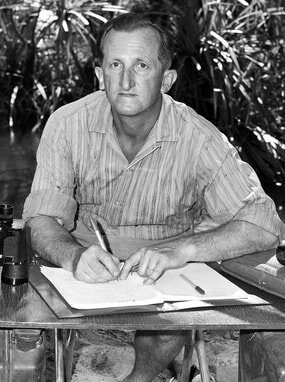 Roman "Ron" Powlowski c.1960s (Source - George Powlowski) Krystyna and Roman immigrated from Poland in the aftermath of WWII.
Roman "Ron" Powlowski c.1960s (Source - George Powlowski) Krystyna and Roman immigrated from Poland in the aftermath of WWII.Roman "Ron" Powlowski(a) was part of the underground when he was a young teenager. His father was killed and his mother sent to prison. He was captured and sent to a German camp in Slovakia. He escaped, went on to serve in the US army, ending up in Australia.
Krys Batowska had her own tale of heartbreak. Her father was arrested by the Russians and exiled to Siberia. She never saw him again. As part of a prisoner of war exchange she was sent to England where she married her first husband. In 1949, the marriage ended and she left for Australia with her three children.
In 1955, Ron and Krys crossed paths in Perth, and married after a week of their meeting. They moved to Karumba where Ron was engaged in gold prospecting.
 Barbara Pawlowski, once threatened by a croc grew up to handle them. c.1960s (source - George Pawlowski) Like many changes in one's life, the path is set by the most unexpected turn of events. The family was by the river, when the adults heard one of the boys yell "Barbara, the crocodile!" Barbara was the boy's 3-year-old sister who was being stalked by a 12-footer. Ron Pawlowski grabbed a rifle and shot the croc between the eyes.
Barbara Pawlowski, once threatened by a croc grew up to handle them. c.1960s (source - George Pawlowski) Like many changes in one's life, the path is set by the most unexpected turn of events. The family was by the river, when the adults heard one of the boys yell "Barbara, the crocodile!" Barbara was the boy's 3-year-old sister who was being stalked by a 12-footer. Ron Pawlowski grabbed a rifle and shot the croc between the eyes.Someone in the town helped them skin it, and a dealer in Brisbane paid them 10 pounds for it. This was equivalent to about a week's wages in those days.
Ron Pawlowski saw opportunity and he built a small boat known as a humpy from scraps found at a meatworks. They christened it the "Joey". Thus the family embarked on their career as crocodile hunters.
The family lived in an outback, tin shack and ate crocodile meat. Despite sometimes not having electricity, Jerzy "George" Pawlowski recalls them as some of the best days of his life. The family ventured into inhospitable terrain as they hunted crocs, all the while learning more about their quarry.
 The Pawlowskis with a crocodile skin The Pawlowskis aimed to shoot the animals behind the ears or through the eyes so they would die immediately.
The Pawlowskis with a crocodile skin The Pawlowskis aimed to shoot the animals behind the ears or through the eyes so they would die immediately. In July, 1957, Krys killed the 28 footer that brought her fame as a relentless crocodile hunter. The animal lay asleep on the banks of a beach in the Gulf of Carpentaria. It was so big that they were unable to move it and harvest the skin.
Over the next 15 years, they killed from 5,000 to 10,000 "salties" as the crocodiles are known, with Krys supposedly missing only 3 shots. Prior to her arrival in Australia she had never fired a rifle.
She learned how to skin the crocs, faster than most and would do so right after a kill.
Ron once told reporters, "She was better than me with a pistol and she was much better with a rifle at moving targets from a boat. We both could hit a bottle top at 100 yards, but Krys could shoot through the same hole the second time."
This earned her the moniker "One Shot". She became an expert not only as a hunter, but as a taxidermist. She was also recognized for her coiffed blonde hair, red manicured nails and scarlet lipstick worn even when on the hunt.
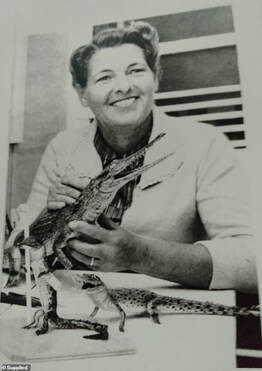 Krys Pawlowski became an expert taxidermist Her son George described where she competed against another croc hunter from up north, who claimed no one could skin a crocodile faster than him. She skinned, cleaned and salted her kill before he was anywhere near finishing.
Krys Pawlowski became an expert taxidermist Her son George described where she competed against another croc hunter from up north, who claimed no one could skin a crocodile faster than him. She skinned, cleaned and salted her kill before he was anywhere near finishing.Eventually the Pawlowski gave up hunting for conservation. During their years of stalking their quarry they noted their mating and eating habits. They became experts in crocodile behavior.
The rivers once thronged by crocodiles were decimated by other hunters who came to make their living the same as the Pawlowskis
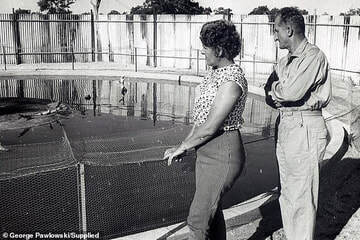 The Pawlowski Croc Farm c.1960s (Source - George Pawlowski) In 1965, the couple started the first crocodile farm in the area. They raised hatchlings from eggs found in the wild, with hopes of farming, conserving and managing the crocodile population. Ron Pawlowski became a self taught photographer and documentarian in the process. Their children hand dug the pools and helped out around the farm.
The Pawlowski Croc Farm c.1960s (Source - George Pawlowski) In 1965, the couple started the first crocodile farm in the area. They raised hatchlings from eggs found in the wild, with hopes of farming, conserving and managing the crocodile population. Ron Pawlowski became a self taught photographer and documentarian in the process. Their children hand dug the pools and helped out around the farm.The political climate of the day didn't favor conservation, and efforts were made to silence the Pawlowski's message. The lease on their farmland was rescinded and sump oil was dumped into their pools where they kept the crocs. They hand cleaned each animal with detergent, only losing one.
In an act foreshadowing Australia's present-day authoritarian tactics, their house was raided for an illegal revolver they used in a documentary. The search yielded nothing since a tip off from a local policeman gave them a heads up and they returned it to its owner. Eventually they had to shut down after a drawn-out battle with the Queensland government.
 Krys Pawlowski on the hunt Times changed and in 1972, Ron Pawlowski gave evidence in the House of Representatives about Wildlife Conservation. He described how in the last 20 years the croc population had declined by 80%. Based on his recommendation the government banned all crocodile hunting.
Krys Pawlowski on the hunt Times changed and in 1972, Ron Pawlowski gave evidence in the House of Representatives about Wildlife Conservation. He described how in the last 20 years the croc population had declined by 80%. Based on his recommendation the government banned all crocodile hunting.Later on Krys said she regretted killing the 28-foot reptile as it lay snoozing on the banks of the Norman River.
A replica of the doomed reptile, named "Krys The Savannah King" is stationed in the middle of the town of Normanton.
Present day George Pawlowski is the owner of Kryscroc Australia. It was established in 1989, in the town of Normanton. They buy and sell tanned crocodile leather products. His family's farm laid the foundation for the leather industry in this part of Australia.
 How big was this salt water crocodile in reality? Urban Myth or Reality?
How big was this salt water crocodile in reality? Urban Myth or Reality?Ron Pawlowski went on to supply a picture that allegedly depicted the 28-footer his wife Krys shot in the summer of 1957. He estimated that it weighed in at two tons.
At first glance the animal appears enormous, however when you take a closer look at the figures next to it, used to give it scale, the actual size is difficult to determine. Also the fact that the people in the picture appear to be dressed in an earlier time period then the 1950s. Some say the picture is from a hunt on the Roper River 50 years prior.
Pictures taken by Ron were said to be lost "in the 1974 floods", and no one else in the town took a picture of what must have been quite a sight in Karumba.
Another source said the crocodile shot by Krys was added to the Guinness Book of Records, with photos supplied by Ron. There is no record of this at Guinness.
According to zoologists familiar with these types of crocodiles, a 28-foot saltie is far outside the maximum size for these animals, including the skull size.
Krystyna Pawlowski died in 2004.
 Lolong once the largest crocodile according to Guinness World Records died in 2013, Stuffed skin (Source - Wikipedia)
Lolong once the largest crocodile according to Guinness World Records died in 2013, Stuffed skin (Source - Wikipedia)
According to Guinness (2022):
The largest crocodile in captivity ever was a 20-ft 2.91-in saltwater crocodile (Crocodylus porosus) captured on September 3, 2011 in Bunawan, in the province of Agusan del Sur, Mindanao, Philippines. The crocodile was named Lolong and housed in a custom-built enclosure at Bunawan Eco-Park and Research Center, Philippines. Lolong was weighed in at a truck weigh-bridge and verified as approximately 2,370 lb. Lolong died on February 10, 2013.
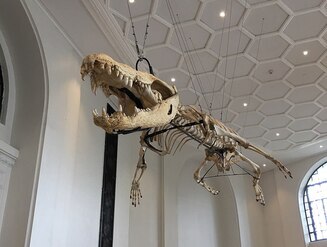 Preserved bones of Lolong (Source - Wikipedia) The crocodile was named after Ernesto "Lolong" Goloran Coñate. He was one of the veteran crocodile hunters from the Palawan Crocodile and Wildlife Reservation Center, who led the hunt. After weeks of stalking, the hunt for Lolong took its toll on Coñate's health. He died of a heart attack several days before the crocodile was captured.
Preserved bones of Lolong (Source - Wikipedia) The crocodile was named after Ernesto "Lolong" Goloran Coñate. He was one of the veteran crocodile hunters from the Palawan Crocodile and Wildlife Reservation Center, who led the hunt. After weeks of stalking, the hunt for Lolong took its toll on Coñate's health. He died of a heart attack several days before the crocodile was captured.Lolong was estimated to be at least 50 years old. The animal was suspected of eating a fisherman who went missing in the town of Bunawan, and also of consuming a 10-year-old girl whose headless body was discovered in 2009, shortly after she fell in a lake when the croc bumped the boat she was traveling in. He was also the primary suspect in the disappearance of water buffaloes in the known area.
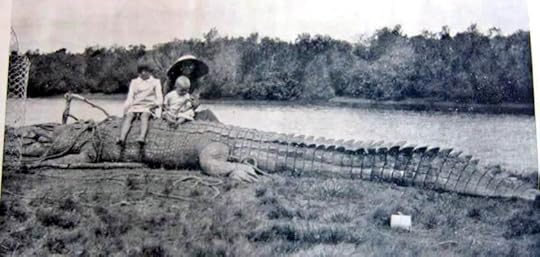
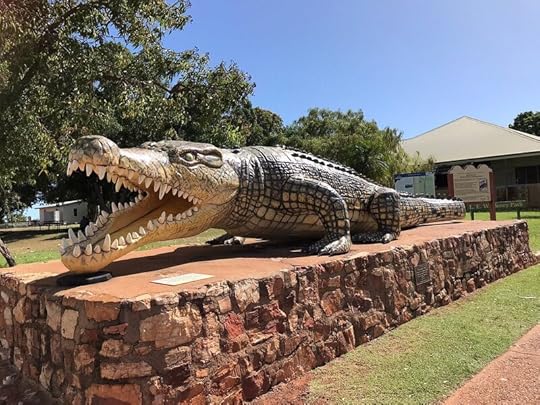


Published on October 24, 2022 08:00



